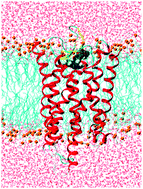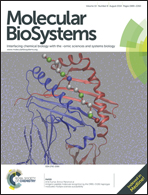Computational insights into the binding mechanism of antagonists with neuropeptide B/W receptor 1†
Abstract
Neuropeptide B/W receptor 1 (NPBWR1), previously known as G-protein coupled receptor 7 (GPR7), is a class A G-protein coupled receptor implicated in the modulation of several neuroendocrine functions such as feeding behavior, energy homeostasis, epilepsy, and analgesia. In recent years, a few antagonists have been designed that bind to NPBWR1 with high affinity. However, the exact binding modes between the antagonists and the receptor are still unknown. Unraveling the key pharmacophoric features of the receptor will guide the development of novel compounds with increased potency for therapeutic use. Here, we studied the structural organization of NPBWR1 receptor and its antagonist binding modes through computational approaches. Based on the dynamics and energetic features of receptor–ligand interactions, we categorized the binding affinities of the antagonists for NPBWR1 and identified key residues responsible for ligand recognition by NPBWR1. Binding free energy calculations revealed that the residues Trp102ECL1, Val1133.29, Gln281ECL3, and Ala2746.58 were crucial for ligand interaction. The results of our study will be useful to understand the structure–function relationship of NPBWR1 that may assist future drug discovery initiatives.


 Please wait while we load your content...
Please wait while we load your content...